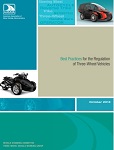Three-wheel vehicles have existed since the earliest days of the motor vehicle. They include varied configurations, including the trike, reverse trike, sidecar motorcycle, and what the Three-Wheel Vehicle Working Group has defined as the “autocycle,” which operates much like a passenger vehicle. These vehicles can vary drastically in price, performance, and design. Manufacturers’ desire to create fuel-efficient vehicles and to cater to people who want to ride a motorcycle but don’t want the worry of the instability of a two-wheel motorcycle have led to a proliferation of three-wheel vehicles on the market.
Jurisdictions are faced with complex and evolving issues regulating the operation and registration of three-wheel vehicles. As a result, the AAMVA formed the Three-Wheel Vehicle Working Group and tasked it with the development of best practices and recommendations for regulating or restricting on-highway operation and registration of three-wheel vehicles. The group focused on creating guidelines that adequately identify the different vehicles in production today but that are broad enough to accommodate emerging vehicle technology.
Most three-wheel vehicles clearly meet the definition of a motorcycle in United States code 49 CFR 571.3(b) and should be regulated as motorcycles. However, two-wheel motorcycles and three-wheel vehicles operate very differently. This document provides guidelines to help jurisdictions determine the type of knowledge and skills testing required for the operation of each type of three-wheel vehicle and the type of driving privilege the operator should obtain. It also offers recommendations for identifying the different types of three-wheel vehicles for registration and crash reporting purposes, which will also help law enforcement easily determine which laws to enforce for the different types of three-wheel vehicles.
Many jurisdictions allow operators of two-wheel motorcycles (tested or trained on a two-wheel motorcycle) to operate any motorcycle yet restrict three-wheel motorcycle operators (tested or trained on a three-wheel motorcycle) to only operating threewheel motorcycles. The 3WVWG recognizes that this practice needs to change and addresses it in the recommended best practices.
 Download
Download
Jurisdictions are faced with complex and evolving issues regulating the operation and registration of three-wheel vehicles. As a result, the AAMVA formed the Three-Wheel Vehicle Working Group and tasked it with the development of best practices and recommendations for regulating or restricting on-highway operation and registration of three-wheel vehicles. The group focused on creating guidelines that adequately identify the different vehicles in production today but that are broad enough to accommodate emerging vehicle technology.
Most three-wheel vehicles clearly meet the definition of a motorcycle in United States code 49 CFR 571.3(b) and should be regulated as motorcycles. However, two-wheel motorcycles and three-wheel vehicles operate very differently. This document provides guidelines to help jurisdictions determine the type of knowledge and skills testing required for the operation of each type of three-wheel vehicle and the type of driving privilege the operator should obtain. It also offers recommendations for identifying the different types of three-wheel vehicles for registration and crash reporting purposes, which will also help law enforcement easily determine which laws to enforce for the different types of three-wheel vehicles.
Many jurisdictions allow operators of two-wheel motorcycles (tested or trained on a two-wheel motorcycle) to operate any motorcycle yet restrict three-wheel motorcycle operators (tested or trained on a three-wheel motorcycle) to only operating threewheel motorcycles. The 3WVWG recognizes that this practice needs to change and addresses it in the recommended best practices.
